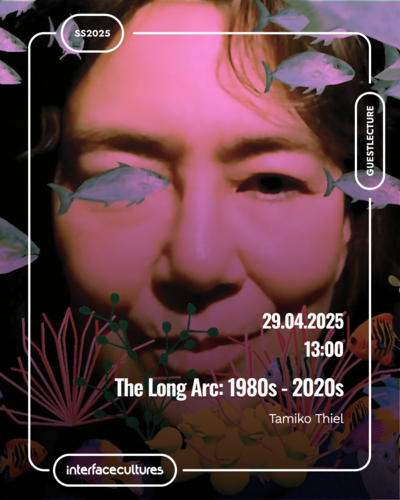Welcome at the Interface Culture program website.
Acting as creative artists and researchers, students learn how to advance the state of the art of current interface technologies and applications. Through interdisciplinary research and team work, they also develop new aspects of interface design including its cultural and social applications. The themes elaborated under the Master's programme in relation to interactive technologies include Interactive Environments, Interactive Art, Ubiquitous Computing, game design, VR and MR environments, Sound Art, Media Art, Web-Art, Software Art, HCI research and interaction design.

The Interface Culture program at the Linz University of Arts Department of Media was founded in 2004 by Christa Sommerer and Laurent Mignonneau. The program teaches students of human-machine interaction to develop innovative interfaces that harness new interface technologies at the confluence of art, research, application and design, and to investigate the cultural and social possibilities of implementing them.
The term "interface" is omnipresent nowadays. Basically, it describes an intersection or linkage between different computer systems that makes use of hardware components and software programs to enable the exchange and transmission of digital information via communications protocols.
However, an interface also describes the hook-up between human and machine, whereby the human qua user undertakes interaction as a means of operating and influencing the software and hardware components of a digital system. An interface thus enables human beings to communicate with digital technologies as well as to generate, receive and exchange data. Examples of interfaces in very widespread use are the mouse-keyboard interface and graphical user interfaces (i.e. desktop metaphors). In recent years, though, we have witnessed rapid developments in the direction of more intuitive and more seamless interface designs; the fields of research that have emerged include ubiquitous computing, intelligent environments, tangible user interfaces, auditory interfaces, VR-based and MR-based interaction, multi-modal interaction (camera-based interaction, voice-driven interaction, gesture-based interaction), robotic interfaces, natural interfaces and artistic and metaphoric interfaces.
Artists in the field of interactive art have been conducting research on human-machine interaction for a number of years now. By means of artistic, intuitive, conceptual, social and critical forms of interaction design, they have shown how digital processes can become essential elements of the artistic process.
Ars Electronica and in particular the Prix Ars Electronica's Interactive Art category launched in 1991 has had a powerful impact on this dialog and played an active role in promoting ongoing development in this field of research.
The Interface Cultures program is based upon this know-how. It is an artistic-scientific course of study to give budding media artists and media theoreticians solid training in creative and innovative interface design. Artistic design in these areas includes interactive art, netart, software art, robotic art, soundart, noiseart, games & storytelling and mobile art, as well as new hybrid fields like genetic art, bioart, spaceart and nanoart.
It is precisely this combination of technical know-how, interdisciplinary research and a creative artistic-scientific approach to a task that makes it possible to develop new, creative interfaces that engender progressive and innovative artistic-creative applications for media art, media design, media research and communication.
Guestlecture Tamiko Thiel
29. April 2025, 13.00 Uhr Kunsthalle Wien, Museumsplatz 1, 1070 Wien
The Long Arc: 1980s - 2020s
Media art is subject to fads, just like any other field of human endeavor. It took about 100 years before photography was accepted as an art form, so I guess we should be grateful that it took "only" 60 years for media art to be accepted. As there was no way to make money off of the work, artists who pursued media art often formed a much stronger - if sparse and widely dispersed - community than the more competitive circles of painters. Access to the institutions and technology needed to make high end media artwork was heavily gated however, and the interests of the person in charge defined what was considered worthy technology, content and artistic approaches. I will talk about my own personal path through this maze, with some insights from what I have seen from colleagues of mine through the decades.
In 2024 Tamiko Thiel was awarded the SIGGRAPH Distinguished Artist Lifetime Achievement Award in Digital Arts and inducted into the inaugural cohort of AWE XR Hall of Fame for her politically and socially critical media artworks exploring place, space, the body and cultural identity. Earlier awards include the 2018 SAT Montreal Visionary Pioneer Award and the 2009 IBM Innovation Award in Art and Technology. Her art practice ranges from the design of the visual form for the first AI supercomputer (1983-1986) to virtual reality (VR, since 1994), augmented reality (AR, since 2010), large immersive installations, videos, digital prints and ceramics. She has major works in the collections of the Museum of Modern Art (MoMA) New York, The Whitney Museum of American Art New York, the Smithsonian Institution in Washington D.C., Roche Basel Art Collection in Switzerland, Broich Digital Art Museum in Frankfurt, and in the private collections of new media pioneers Lynn Hershman Leeson and Eduardo Kac.
